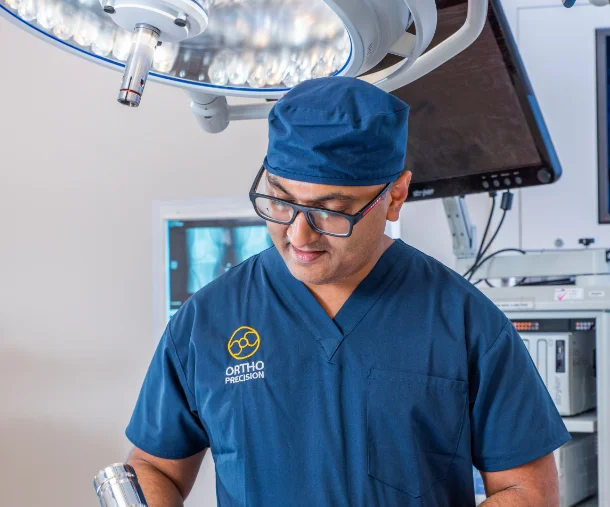Femoroacetabular Impingement (FAI)
Femoroacetabular Impingement (FAI) is a condition that affects the hip joint, causing pain and limiting movement. As a leading orthopaedic surgeon in Adelaide, Australia, Dr Yas Edirisinghe from Ortho Precision specialises in diagnosing and treating this condition. This guide provides an in-depth look at FAI, covering its definition, symptoms, diagnosis, and treatment options.
What is Femoroacetabular Impingement (FAI)?
Femoroacetabular Impingement (FAI) is a condition in which abnormal contact between the bones of the hip joint leads to damage. The hip joint is a ball-and-socket joint, where the ball (femoral head) at the top of the thighbone fits into the socket (acetabulum) in the pelvis. FAI occurs when the femoral head and the acetabulum do not fit together perfectly, causing friction during movement.
Types of FAI
- Cam Impingement: This type occurs when the femoral head is not perfectly round and cannot rotate smoothly inside the acetabulum. The misshapen head causes rubbing and grinding, leading to cartilage and labrum damage.
- Pincer Impingement: This type happens when the acetabulum covers too much of the femoral head, leading to pinching of the labrum between the acetabular rim and the femoral head.
- Combined Impingement: Many individuals have a combination of both cam and pincer impingement.
Causes
- Genetics: Some people are born with structural abnormalities that predispose them to FAI.
- Repetitive Movements: Activities that involve repetitive hip flexion, such as certain sports, can contribute to the development of FAI.
- Growth Abnormalities: During childhood, abnormal growth of the hip bones can lead to FAI.
Symptoms of Femoroacetabular Impingement (FAI)
The symptoms of FAI can vary in severity and may be mistaken for other hip conditions. Recognising the signs of FAI is crucial for early diagnosis and treatment.
Common Symptoms
- Hip Pain: Pain is typically felt in the groin area but can also occur on the outside of the hip or the buttocks. The pain may be sharp or dull and often increases with activity.
- Limited Range of Motion: Patients may experience stiffness and a reduced range of motion in the hip, particularly during activities that involve bending at the hip.
- Clicking or Catching Sensation: Some individuals report a clicking, locking, or catching sensation in the hip joint.
- Pain with Specific Movements: Activities such as squatting, turning, and prolonged sitting can exacerbate the pain.
Activity-Related Symptoms
- Increased Pain with Activity: Physical activities, especially those involving hip flexion and rotation, can worsen the symptoms.
- Difficulty with Sports: Athletes may notice decreased performance and increased discomfort during their sports activities.
Diagnosis of Femoroacetabular Impingement (FAI)
Accurate diagnosis of FAI is essential for effective treatment. Dr Yas Edirisinghe uses a combination of clinical evaluation and imaging studies to diagnose this condition.
Clinical Evaluation
- Medical History: A thorough medical history helps identify any previous hip injuries, sports participation, and the onset and nature of symptoms.
- Physical Examination: A detailed physical examination of the hip, including specific manoeuvres to reproduce the symptoms, can provide clues to the presence of FAI. Tests such as the FADIR (flexion, adduction, and internal rotation) and FABER (flexion, abduction, and external rotation) are commonly used.
Imaging Studies
- X-rays: X-rays are often the first imaging study performed and can reveal the bone shapes of the hip joint and any structural abnormalities indicative of FAI.
- Magnetic Resonance Imaging (MRI): MRI provides detailed images of the soft tissues, including the labrum and cartilage, helping to identify associated damage.
- CT Scan: In some cases, a CT scan may be used to provide a more detailed view of the bone structures and any abnormalities.

Rehabilitation
Post-surgery rehabilitation is crucial for a successful recovery. Physical therapy focuses on gradually restoring range of motion, strength, and stability. Patients are typically advised to avoid high-impact activities during the initial recovery period and follow a tailored rehabilitation plan provided by their healthcare team.
Treatment of Femoroacetabular Impingement (FAI)
The treatment of FAI depends on the severity of the condition, the patient’s symptoms, and their activity level. Dr Yas Edirisinghe offers a range of treatment options, from conservative management to surgical intervention.
Conservative Treatment
- Activity Modification: Reducing activities that exacerbate symptoms can help manage pain and prevent further damage.
- Physical Therapy: A structured physical therapy program focuses on strengthening the muscles around the hip, improving flexibility, and enhancing joint stability. Specific exercises can help alleviate symptoms and restore function.
- Medications: Nonsteroidal anti-inflammatory drugs (NSAIDs) can reduce pain and inflammation.
- Injections: Corticosteroid injections into the hip joint can provide temporary relief from pain and inflammation.
Surgical Treatment
When conservative treatments fail to provide sufficient relief, surgical intervention may be necessary. Hip arthroscopy is the most common surgical procedure used to treat FAI.
Hip Arthroscopy
- Procedure: This minimally invasive surgery involves making small incisions around the hip joint. An arthroscope (a small camera) and surgical instruments are inserted through these incisions. The surgeon can then visualise the hip joint and address the bony abnormalities and any associated labral or cartilage damage.
- Repair Techniques: The surgeon may shave down the excess bone on the femoral head (cam impingement) or acetabulum (pincer impingement) to improve the fit of the hip joint. Labral tears can also be repaired or debrided during the procedure.
- Recovery: Postoperative recovery includes a period of rest followed by a structured rehabilitation program to restore hip function and strength. Full recovery can take several months, but most patients experience significant improvement in pain and mobility.

Dr Yas Edirisinghe at Ortho Precision in Adelaide offers comprehensive care for patients with FAI, from initial diagnosis through to recovery. If you suspect you have FAI or are experiencing hip pain, Dr Edirisinghe and his team are available for consultation and can be reached through the chat feature on the Ortho Precision website.
With expert care and advanced treatment options, patients can look forward to improved hip function and a return to their active lifestyles.
Advanced, patient-centred technology for better outcomes.
Contact us via the contact page or chatbot available across our website and Dr Yas will respond promptly.
